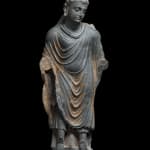



Unknown
Standing Buddha Gandhara, 2nd/early 3rd century
Grey Schist
71 cm tall (76 cm plus base) x 30 x 20 cm
base: 25 x 19 x 7.5 cm
base: 25 x 19 x 7.5 cm
Series: cracked
Further images
The sensitive and beautiful figure of the Buddha is sculpted in high relief against a full length backing. He appears to turns his head to his left and he looks...
The sensitive and beautiful figure of the Buddha is sculpted in high relief against a full length backing. He appears to turns his head to his left and he looks down, indicating that small companion figures once accompanied him. This figure represents the bridge between the early narrative scenes of 2nd century Gandhara and the emergence of freestanding iconic images that began at the end of the 2nd century.
The clue to the identity of the Buddha’s lost companions lies in the projection of his right arm and positioning of his wrists; although both hands are now missing, the right hand was clearly held lower than the left. The figure appears to illustrate the popular story of Jaya, a child who followed his parents’ example in placing an offering of food in the Buddha’s bowl,butcouldonlyofferdust(Fig.6). The Buddha regarded this as a spontaneous, unconditional act of charity.
This Buddha did not raise his hand in Abhayamudra (Fig. 7), the gesture commonly seen in iconic images and it is most likely that he held an alms bowl. A few later iconic images of the Buddha depict him holding the alms bowl (Fig. 8). By then, devotees would have been familiar with the legend but the statues had probably come to symbolise punya (the charitable, karma-accruing act of giving) rather than this specific event. The sculpture under review seems to embrace both the legend and the concept of punya.
The clue to the identity of the Buddha’s lost companions lies in the projection of his right arm and positioning of his wrists; although both hands are now missing, the right hand was clearly held lower than the left. The figure appears to illustrate the popular story of Jaya, a child who followed his parents’ example in placing an offering of food in the Buddha’s bowl,butcouldonlyofferdust(Fig.6). The Buddha regarded this as a spontaneous, unconditional act of charity.
This Buddha did not raise his hand in Abhayamudra (Fig. 7), the gesture commonly seen in iconic images and it is most likely that he held an alms bowl. A few later iconic images of the Buddha depict him holding the alms bowl (Fig. 8). By then, devotees would have been familiar with the legend but the statues had probably come to symbolise punya (the charitable, karma-accruing act of giving) rather than this specific event. The sculpture under review seems to embrace both the legend and the concept of punya.










